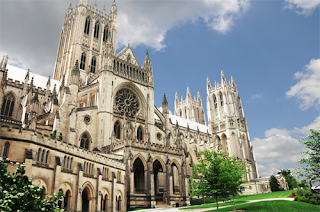Come on in the Cathedral--if you have $10
Many folk say it is horrible to charge admission to a church. But others point out one pays admission for churches elsewhere. I myself have dodged admission fees at major churches in Europe by attending a service to hear the music (and I have given money anyway). Others note that the development department is not very successful if the church has to resort to admission charges, an observation that probably has some truth to it. But I think the problem with the cathedral is not really income.
The cathedral's problem is relevance as a church. When I worked there, about three quarters of a million people entered the building every year. Well over two thirds of them were tourists, there to see a big pretty building instead of a place of worship. It was a favorite alternative destination for school bus tours when rainy days precluded wandering around the nearby National Zoo. Rarely did attendance at all the services on a Sunday surpass 1500 people, and even that was based on liberal counts by the vergers (if a person was wandering around looking at stained glass during a service, he counted as a worshipper). Easter and Christmas services drew large crowds as do all churches for those feasts, sometimes of a very elite nature (colleagues who worked the door have told me of being spat upon by an inebriated woman in a Chanel suit when told there was no room for her on Christmas Eve.). But what went on in the church most of the time rarely drew the interest of many folk.
The cathedral hailed itself as a National House of Prayer for All People, though all the services were Episcopalian, as it is the cathedral for the Diocese of Washington DC and the Episcopal Church of the US. However, the biggest crowd at any event there during my six years as an employee was for a teaching by the Dalai Lama, which filled the church to capacity, with several thousand sitting outside on the grounds listening on loudspeakers. Other than that and the big feast days, the only large crowd was typically when graduation exercises were held inside for the nearby elite Episcopal schools.
When I worked there, I used to explain to people the reason the building was so big was to fit the egos of all the people who worked there. The vain and the pretentious flocked to the place as employees and in other roles. It was a great place to get married if your wedding party exceeded sixteen or if the bride and groom show up in their matching Bentleys (we had some of those. My boss used to say the number of years a marriage lasted was inversely proportional to the size of the wedding party). Now I truly enjoyed making music there and seeing how the place moved and inspired people. Ok, I also cherished a commute of five minutes from my apartment. But the place had real trouble connecting to the people of the city. A major difficulty is it is buried in the middle of the most prosperous and pretentious ward of the city, remote on the hill from the rest of the population, partially by intent of its creators. It rarely involved itself in the city and the life of its citizens who were not connected to the institutions of the Cathedral Close. Those drawn to its grandeur as a reflection of their own importance tended to repel others, so developing the community that churches tend to gather was a challenge. There tended to be a big emphasis on the show at services rather than the action of the church outside of the building.
Some of the clergy didn't tend to be community builders or very pastoral. When fellow employees used to complain about the cathedral's clergy, I liked to give the following explanation about how our collared folk ended up serving at the cathedral. Seminaries craft priests out of many kinds of people. Some are very charismatic, drawing and inspiring people to them and the organizations they serve. They make splendid missionaries, bringing in the new faithful Some are very able educators, adept at explaining the words and ideas of the faith and bringing it alive to people. They make teachers in seminaries and schools, passing on their beliefs. Some have a true love of all the elements of human life, from birth through marriage and ultimately death (in the Worship Office, we used to call it hatching, matching, and dispatching). They make great pastors of churches, helping parishioners through the stages of life. But some priests don't have these gifts, so God created cathedrals to give them a place to work.
I remember speaking about the cathedral's perpetual issues with a former lay administrator that I ran into often professionally after we had both left the cathedral. She told me the cathedral had hired consultants over the years to study the cathedral, how it worked and didn't work. Time and again the findings were essentially that the employees of the nominally Christian institution did not think or interact in a Christian manner. Perhaps the place could have learned more from the Rabbi than from the management consultants.
The admissions charge will no doubt help the cathedral limp along. Officials noted it may encourage more people to become members of the Cathedral association or to spend more at the souvenir shop. I guess this means they have already given up on attracting people to the cathedral as a religious space.




Comments
Post a Comment